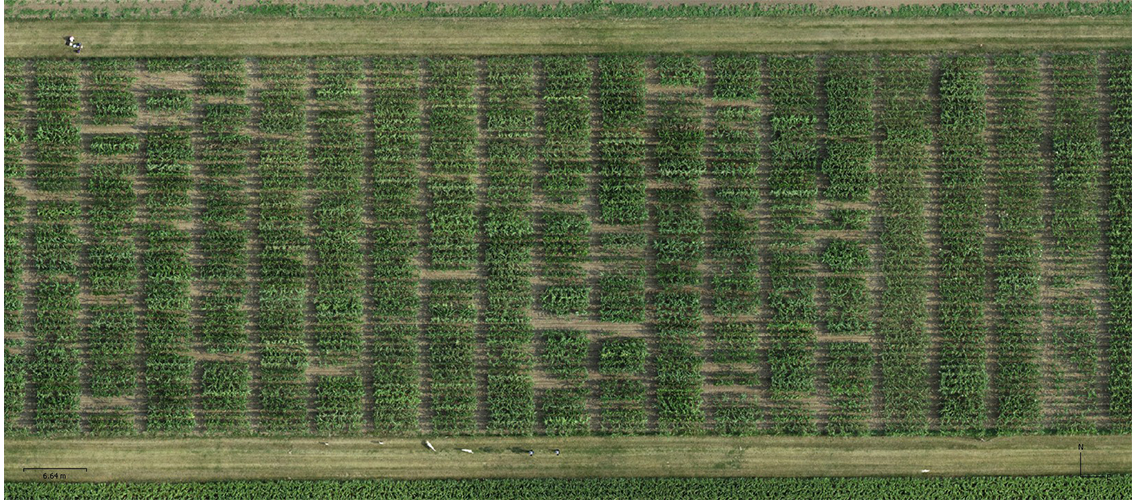Improving Crops Using High-Throughput Phenotyping
Breeding climate-resilient crops and developing targeted management practices are imperative to strengthening global food security. Climate change has created unpredictable environments with an increase in extreme weather events that are directly impacting the global food supply. Breeding climate-resilient crops and implementing informed in-season management practices are critical to deliver a more reliable harvest product in the face of challenging growing conditions.
PhD candidate Dorothy Sweet (Applied Plant Sciences program) worked on a project called Using High Throughput Phenotyping to Enable a Sustainable Food System as a UMII MnDRIVE PhD Graduate Assistant. This project used high throughput phenotyping to monitor maize plant growth throughout the season as an indicator of plant health and a potential predictor of end of season performance. This approach uses unoccupied aerial vehicles (UAVs) to collect images of experimental plot fields and farmer production fields at a high temporal resolution, which are then processed to obtain plant height information for every plant in the field to calculate growth curves for each plant throughout the growing season. This kind of data was collected for multiple experiments and many acres of production land over multiple years to understand how plants interact with and respond to their environment and how this information can be used to breed for climate tolerant crops and guide management practices that protect our global food supply in a sustainable way. The experimental data was specifically used to characterize how diverse maize genotypes respond to environmental conditions and identify genes that control those environmental changes with growth rate as a measure of responsiveness to the environment. Identifying the way genotypes respond and the genes that control those responses is important in identifying genotypes that will successfully survive environmental fluctuations such as cold snaps or floods, especially early in the growing season. The UAV data collected over production land was used in conjunction with harvested yield data to identify early season growth patterns that are predictive of end of season yield for hybrids grown under diverse growing conditions. This research determined that end of season yield can be reasonably predicted assuming there is sufficient water and leveraged for management strategies, however, without sufficient water, soil type and depth to the water table have more influence on the yield.
Advances in this area will be critical to providing food stability as we face increasingly challenging growing conditions and a need to increase crop production to meet the needs of our growing population size. In addition to moving toward food stability, applications of this research to precision agriculture practices will help reduce excess pesticide use and nutrient pollution in farming communities.
Ms. Sweet did this research under the supervision of MSI PIs Candice Hirsch (professor, Agronomy and Plant Genetics) and Cory Hirsch (associate professor, Plant Pathology) and used MSI resources for this project.
The following publications and presentations resulted from this research:
- Sweet, D., Tirado, S., Springer, N., Hirsch, C.N., Hirsch, C.D., (2022) Opportunities and challenges in phenotyping row crops using drone-based RGB imaging. The Plant Phenome Journal. In Print.
- Sweet, D., Tirado, S., Cooper, J., Springer, N., Hirsch, C.D., Hirsch, C.N., (2023) Temporally resolved growth patterns reveal variability in environmental responsiveness in diverse maize panel. (In preparation for The Plant Phenome Journal).
- Sweet, D. (2023, February). Temporal analysis of maize plant height and growth rate using UAV captured imagery. Invited Scientific Talk at NAPPN 2023 Conference, Donald Danforth Plant Science Center, Saint Louis, Missouri.
- Sweet, D., Tirado, S., Cooper, J., Springer, N., Hirsch, C.D., Hirsch, C.N. (2023, March). Temporal analysis of maize plant height and growth rate using UAV captured imagery. Poster at 65th Annual Maize Genetics Meeting, Saint Louis, Missouri.
Sweet, D., Tirado, S., Cooper, J., Springer, N., Hirsch, C.D., Hirsch, C.N. (2023, February). Temporal analysis of maize plant height and growth rate using UAV captured imagery. Poster at NAPPN 2023 Conference, Donald Danforth Plant Science Center, Saint Louis, Missouri.
Project dataset: Temporally resolved growth patterns in diverse maize panel (https://doi.org/10.13020/SKJN-QX31).
The UMII MnDRIVE Graduate Assistantship program supported U of M PhD candidates pursuing research at the intersection of informatics and any of the five MnDRIVE areas:
- Robotics
- Global Food
- Environment
- Brain Conditions
- Cancer Clinical Trials
This project was part of the Global Food MnDRIVE area.
The UMII program was converted to the Data Science Initiative-MnDRIVE Graduate Assistantship program in the fall of 2023. Research supported by the program is at the intersection of data science and the five MnDRIVE areas. The most recent Assistantships were announced in January 2024. The application period for the next awards will be announced in Fall 2024.
Image description: Drone photo of an experimental corn field.
